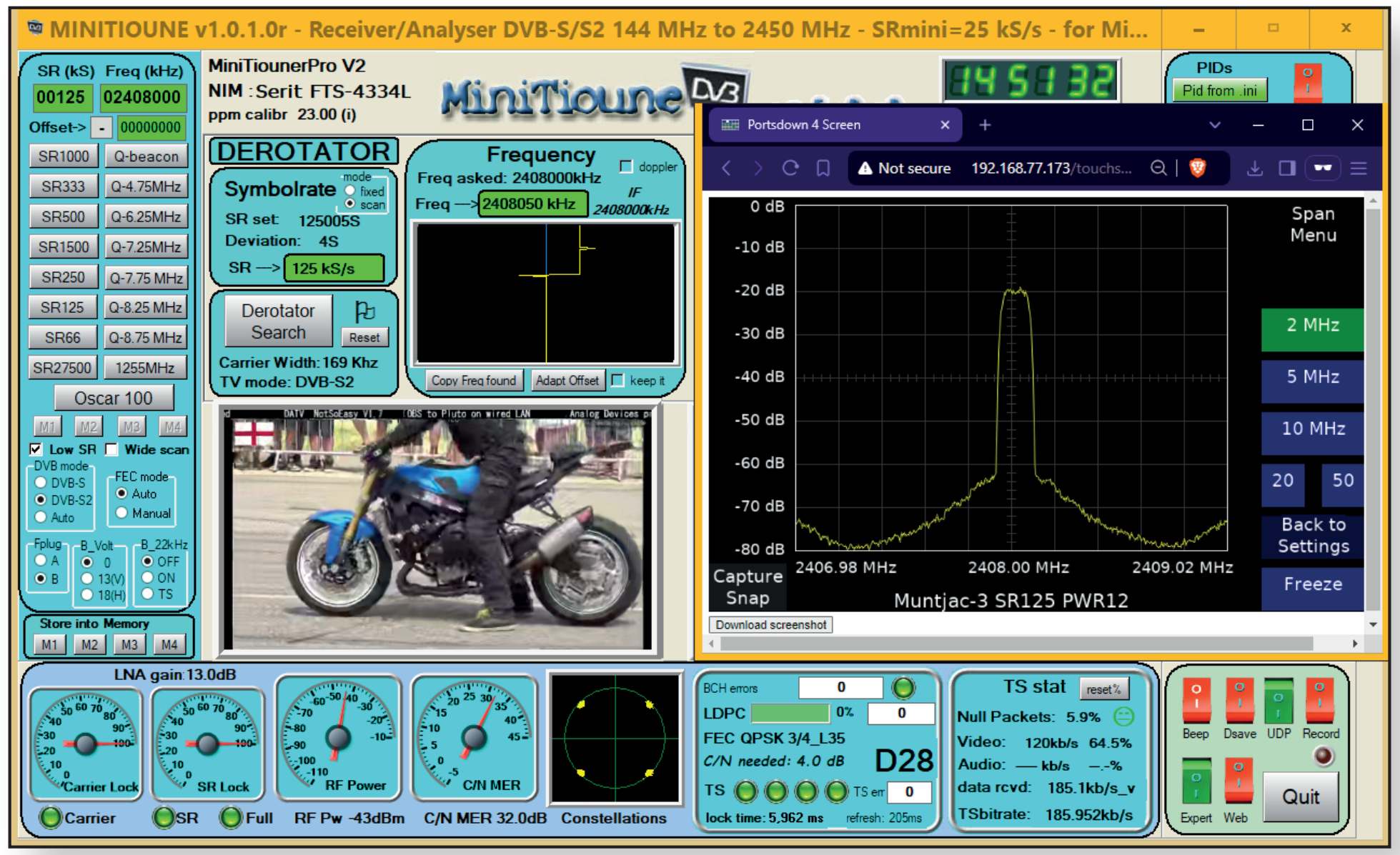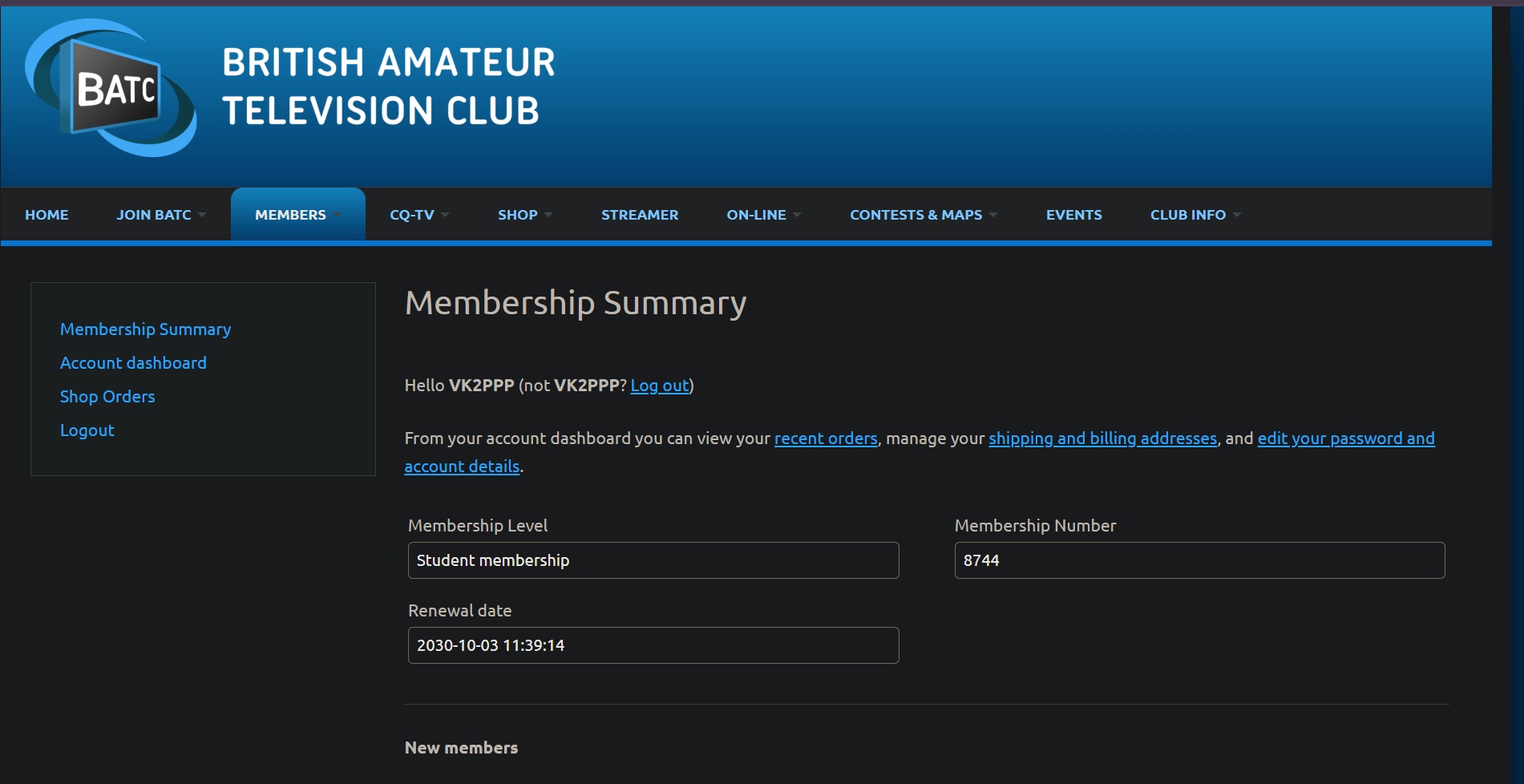Over the past month, I’ve been deeply interested in DATV and explored many homebrew DATV encoders and decoders created by our fellow HAMs. Previously, I had researched various DVB communication protocols, most of which operate in wide dedicated service bands with bandwidths reaching 6–8 MHz. Within such a bandwidth, the transmitted bitrate of the stream can easily exceed 10 Mb/s.
However, it’s clear that amateur radio doesn’t grant us access to such generous bandwidth—radio spectrum is far too valuable a resource. This naturally raises the question: in amateur radio, and especially on the QO-100 satellite, what kinds of encoding methods are actually used for DATV transmission?
In HAM amateur television (DATV), the commonly used symbol rates and bitrates generally fall within the following ranges, based on practical experience with QO-100, the 70 cm band, the 23 cm band, and other popular allocations:
Frequently Used Symbol Rates (SR)
- 66 kS/s – ultra-low rate; narrowband tests and some QO-100 NB experiments.
- 125 kS/s – very common “low-rate entry” setting
- 250 kS/s – popular on QO-100; clearer low-res video.
- 333 kS/s – widely used community “standard,” good balance of rate vs. bandwidth.
- 500 kS/s – higher quality (often 360p–480p) but wider bandwidth.
- 1 MS/s – ~1.3 MHz occupied BW; near-SD quality, needs more power.
- 2 MS/s+ – mostly local terrestrial links; rarely on satellites due to bandwidth use.
Approximate Throughput (QPSK, FEC 3/4, pilots on; includes ~8–10% overhead)
| SR (kS/s) | Occupied BW (≈) | TS bitrate (kb/s) | Safe video bitrate (kb/s) | Suggested video (H.265) |
|---|---|---|---|---|
| 66 | ~90 kHz | ~100 | 60–70 | 160×120 or QCIF @15 fps |
| 125 | ~170 kHz | ~186 | 120–150 | 240p @25 fps or 320×180 |
| 250 | ~340 kHz | ~372 | 250–300 | 288p–360p @25 fps |
| 333 | ~450 kHz | ~500 | 350–400 | 360p @25 fps |
| 500 | ~670 kHz | ~744 | 500–600 | 480p @25 fps (simple scenes) |
| 1000 | ~1.3 MHz | ~1490 | 1000–1200 | 576p/SD @25 fps |
Notes
- Prefer H.265/HEVC at low bitrates; use H.264 if decoder compatibility matters.
- Reserve 12–20 kb/s for audio (HE-AAC mono) or mute to save bits.
- Keep ~10% TS headroom to avoid overflows and glitches.
From this, it’s clear that DATV transmissions usually occupy only a tiny slice of bandwidth. The trade-off, however, is very low bitrate and resolution. This also explains why, in magazines or demo videos, the received images often show large areas of pixelation.

This image is taken from Page 15, issue 285 of CQ-TV magazine. Originally credit by BATC.org.uk
Bandwidth Calculation for the 125 kS/s DVB-S2 Signal
The symbol rate (SR) is 125 kS/s.
According to the DVB-S2 roll-off factor (typically 0.2–0.35),
the theoretical occupied bandwidth can be estimated as:
Bandwidth ≈ SR × (1 + α), Taking α = 0.35: 125 kHz × 1.35 ≈ 169 kHz
We can check this calculation result by finding it directly in the screenshot, where:
- In the MiniTioune software, under the DEROTATOR panel, the value
Carrier Width: 169 kHzdirectly indicates the occupied bandwidth. - In the right-hand Portsdown 4 spectrum display (center frequency at 2408 MHz),
the signal rises from below −60 dB up to the main lobe and then falls back down.
The overall main-lobe width visually corresponds to roughly 160–180 kHz,
which matches the measured result.
Compared with standard DVB-S2 up/down link signals
For comparison, I’ve also included tables here showing the typical bandwidth and bitrate information used in DVB-S2 satellite uplinks and downlinks.
1. Professional / Commercial DVB-S2 Broadcast Systems
| Resolution | Codec | Frame Rate | Video Bitrate (Mbps) | Typical Bandwidth (MHz) | Typical Usage |
|---|---|---|---|---|---|
| SD 576i / 480p | H.264 | 25–30 | 2–4 | 2–3 | Legacy SD broadcast |
| HD 720p | H.264 | 25–50 | 4–6 | 4–5 | Standard HD |
| Full HD 1080i/p | H.264 | 25–30 | 6–10 | 5–8 | Mainstream satellite TV |
| Full HD 1080p50/60 | H.265 | 50–60 | 6–12 | 5–9 | Modern HD feed |
| 4K UHD (2160p) | H.265 | 50–60 | 15–30 | 10–20 | 4K channels / pro links |
| Contribution feed | H.264/H.265 | 50–60 | 15–50 | 10–30 | Live backhaul / ENG |
| Studio master link | JPEG2000/H.265 | 50–60 | 50–150 | 30–90 | Studio or OB van link |
2. Amateur / Experimental DVB-S2 (DATV, QO-100, Ground Links)
| Symbol Rate (kS/s) | Modulation | FEC | Codec | Video Bitrate (kbps) | Occupied BW (kHz) | Typical Use |
|---|---|---|---|---|---|---|
| 66 | QPSK | 3/4 | H.265 | 80–100 | ~90 | Ultra-narrow test |
| 125 | QPSK | 3/4 | H.265 | 120–150 | ~170 | QO-100 narrowband |
| 250 | QPSK | 3/4 | H.265 | 250–300 | ~340 | 288p–360p |
| 333 | QPSK | 3/4 | H.265 | 350–400 | ~450 | DATV “standard” |
| 500 | QPSK | 3/4 | H.265 | 500–600 | ~670 | 480p |
| 1000 | 8PSK | 3/4 | H.265 | 1000–1200 | ~1.3 MHz | 576p–720p |
| 2000 | 8PSK | 3/4 | H.265 | 2000–2500 | ~2.7 MHz | 720p–1080p low-rate |
| 3000 | 8PSK/16APSK | 3/4 | H.265 | 3000–5000 | ~4.0 MHz | 1080p25 HD |
| 5000 | 16APSK | 3/4 | H.265 | 5000–8000 | ~6.7 MHz | HD broadcast link |
| 8000 | 16/32APSK | 3/4 | H.265 | 8000–12000 | ~10.7 MHz | Professional link |
3. Recommended (H.265) Bitrate vs. Quality Reference
| Target Quality | Resolution / Frame Rate | Bitrate | Modulation | Approx. Bandwidth (MHz) | Comment |
|---|---|---|---|---|---|
| Low Quality | 240p@25 | 0.2–0.3 Mbps | QPSK 3/4 | 0.2–0.3 | Narrow DATV (QO-100) |
| Medium Quality | 480p@25 | 0.5–1.0 Mbps | QPSK 3/4 | 0.4–0.8 | Compact low-power link |
| Standard Definition (SD) | 576p@25 | 1.5–2.0 Mbps | QPSK/8PSK 3/4 | 1.3–2.0 | Solid SD broadcast |
| High Definition (HD) | 720p@25–30 | 2.5–4.0 Mbps | 8PSK 3/4 | 2.0–3.5 | Clear HD feed |
| Full HD (FHD) | 1080p@25–30 | 5–8 Mbps | 8PSK/16APSK 3/4 | 4.5–7.0 | Typical DVB-S2 HD |
| Ultra HD (UHD) | 4K@30–60 | 15–30 Mbps | 16APSK/32APSK 3/4 | 9–20 | Professional 4K link |
4. Bandwidth Usage Ranking (Approximate)
| Rank | Bandwidth Range (MHz) | Typical SR (MS/s) | Video Bitrate Range | Category | Notes |
|---|---|---|---|---|---|
| ① | < 0.5 MHz | ≤ 0.3 | 0.1–0.5 Mbps | Ultra-narrow DATV | Fits QO-100 narrowband window |
| ② | 0.5 – 1 MHz | 0.3–0.8 | 0.5–1.0 Mbps | Narrowband HD test | Raspberry Pi H.265 feasible |
| ③ | 1 – 3 MHz | 0.8–2.0 | 1–3 Mbps | Portable ground link | Good compromise for 720p |
| ④ | 3 – 7 MHz | 2.0–5.0 | 3–8 Mbps | Standard HD DVB-S2 | Typical 1080p broadcast |
| ⑤ | 7 – 15 MHz | 5–10 | 8–15 Mbps | High-end / studio HD | Used by contribution feeds |
| ⑥ | > 15 MHz | > 10 | 15–50 Mbps | 4K / professional | Requires strong uplink and SNR |
Special Thanks
Finally, I’d like to express my gratitude to BATC and Tony G3UIS from BATC Membership Secretary!
They have a wonderful policy of offering five years of free membership to full-time students under the age of 25. I applied for it and received a reply within a single day. I’m truly grateful to them for giving me access to such an excellent magazine subscription—it has been incredibly valuable for my learning and research.

Conclusion
This note presents a comparative analysis of DVB-S2 modulations with various parameters, evaluating their supported video bitrates, resolutions, and bandwidth usage. With the continuous advancement of coding technologies, the amount of information that can be transmitted within the same bandwidth has been repeatedly pushed to new limits, greatly driving the development of modern communication systems.
This is extremely valuable for understanding and learning communication principles, as well as for innovating based on them.